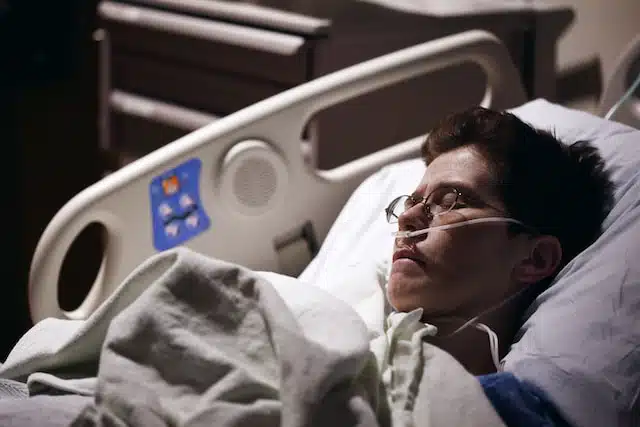
Introduction
Pneumonia. Sounds rather familiar, doesn’t it? However, before you muse over that nasty bout you battled last winter, brace yourself! The vast world of pneumonia is not just limited to a solitary type. From its origins to the cheeky bugs causing it, let’s navigate through the winding alleys of different types of pneumonia: community-acquired, hospital-acquired, and intensive care pneumonia. Furthermore, we’ll also demystify the differences between typical and atypical pathogens and those particularly troublesome multidrug-resistant pathogens. Fancy a deep dive?
1. Pneumonia Demystified: A Thorough Examination
Ever had that dreadful sensation of trying to catch a breath but feeling utterly constricted? That’s pneumonia, mate! But what’s the nitty-gritty?
- Pneumonia, What Are You? It’s an inflammatory condition affecting the lungs. Basically, those tiny alveoli (air sacs) in the lungs get inundated with fluid or pus. Proper unpleasant!
- Symptoms to Spot: Expect a nasty cough (not the casual throat-clearing kind), fever, chills, and breathlessness. It feels as if you’ve been run over by a double-decker bus!
- The Rogues Behind It: Pneumonia can be instigated by various pathogens, including bacteria, viruses, and fungi. It’s like an uninvited rave happening in your lungs!
2. The Many Faces of Pneumonia: Where Did It Originate?
Community-Acquired Pneumonia (CAP)
Acquired outside of healthcare establishments.
- Origins Explored: Simply put, CAP is contracted in everyday locales — could be from that bloke who sneezed at the pub or your little one who believes in sharing everything, even germs.
- Predominant Perpetrators: Most often, the bacterium Streptococcus pneumoniae is the prime suspect. But viruses, particularly the flu, can also be the culprits.
Hospital-Acquired Pneumonia (HAP)
Contracted post-admission in a hospital for unrelated ailments.
- The Irony of It All: You’d reckon hospitals to be safe havens, right? Think again! Sometimes, it’s the very place where pneumonia strikes, especially if you’ve been an occupant for over 48 hours.
- Regular Rogues: Bacteria such as Staphylococcus aureus and Pseudomonas aeruginosa are frequent offenders here. They’re like the unwanted guests who overstay their welcome!
Intensive Care Pneumonia
Acquired in, unsurprisingly, the Intensive Care Unit (ICU).
- High-Stakes Scenario: The ICU is a hotspot, with patients critically ill and consequently, more susceptible to pneumonia.
- Prominent Perpetrators: Like HAP, ICU pneumonia can be caused by myriad bacteria. However, given the gravity of ICU cases, the ramifications are typically more dire.
3. The Usual Vs. The Undercover: Distinguishing Pathogens
Differentiating between these chaps is like comparing tea with coffee: both invigorating, but starkly distinct!
Typical Pathogens
- Regular Rascals: These encompass entities such as Streptococcus pneumoniae and Haemophilus influenzae.
- Manifestation: High temperatures, prolific coughs, and the occasional chest discomfort are the trademarks.
Atypical Pathogens
- The Undercover Operatives: Examples include Mycoplasma pneumoniae and Legionella pneumophila.
- Presentation: These tend to be milder, with symptoms like a low-grade fever and dry cough. They can also meddle with one’s digestive tract. Sneaky, isn’t it?
4. The Belligerent Multidrug-Resistant Pathogens
Just as you think you’ve got the hang of pneumonia, in step the multidrug-resistant pathogens. They’re like the supervillains of the microbial universe!
- The Challenge They Pose: Over time, these pathogens have evolved, building resistance to a slew of antibiotics. They’re fortified to the hilt!
- The Key Offenders: Methicillin-resistant Staphylococcus aureus (MRSA) and certain strains of Pseudomonas aeruginosa stand out. They’re the true troublemakers!
Common Queries Answered
- How can one prevent pneumonia? Certainly! Vaccinations are your best bet. And don’t forget, cleanliness is next to godliness.
- Is every type of pneumonia grievous? Not always. Some can be a mere hiccup, while others can be full-blown debacles. Always seek advice from a medical practitioner!
- How long does pneumonia typically last? It’s a mixed bag. Some recover in a fortnight, while others might take longer. Adequate rest, prescribed medication, and tender loving care are essential.
- Are antibiotics always effective? Not in cases with multidrug-resistant pathogens. Hence, it’s paramount to seek proper medical guidance and complete antibiotic courses.
- Can you get pneumonia more than once? Unfortunately, yes. Pneumonia can recur, so preventive measures remain critical.
Concluding Remarks
Pneumonia is no mere monolith. From community-acquired to intensive care pneumonia, there’s a spectrum to consider. And when it’s about typical versus atypical pathogens and the formidable multidrug-resistant pathogens, the narrative becomes even richer. So, the next time you broach the subject of pneumonia, recall the profound diversity that exists. Stay enlightened and breathe without hindrance!
GET IN TOUCH
Schedule a Visit with Dr Ricardo Jose
Disclaimer: The information provided in this article is for informational purposes only and is not a substitute for professional medical advice, diagnosis, or treatment. Always seek the advice of your healthcare provider with any questions you may have regarding a medical condition or treatment

